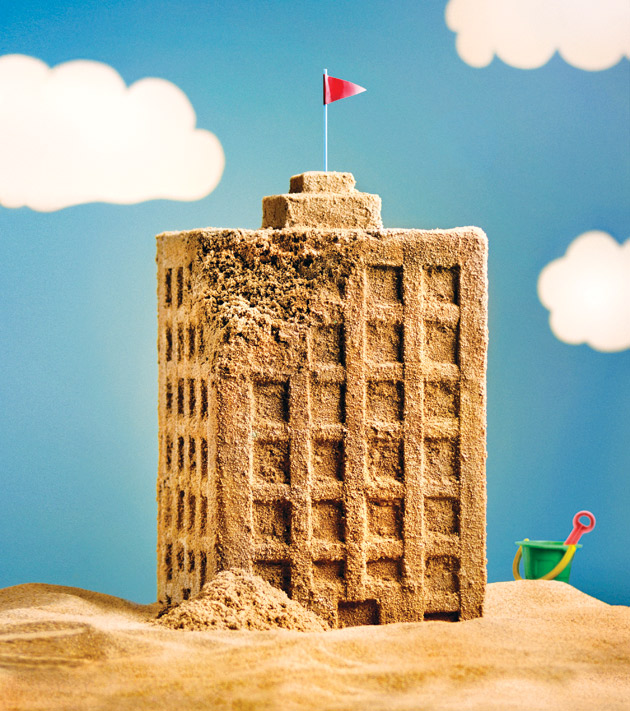As a result, the construction industry has begun to modify how buildings are designed, constructed, managed and maintained. The building envelope is particularly vulnerable to even minor changes in weather conditions. A 25% uptick in peak wind gusts, for example, would cause a corresponding increase in building envelope damages.
As the traditional building practices gradually change in reaction to a changing climate, the foremost concern for the construction industry must be the health and safety of building occupants. One major issue is indoor air quality. People in cold climate regions spend 60%-90% of their time indoors and, in addition to temperature extremes, occupants can be adversely affected by changes in humidity levels, air quality and by the presence of chemicals, pollutants, insects or mold.
The premature weathering or deterioration of building enclosure systems themselves is another vital concern. Not surprisingly, this is quickly becoming a focus for many regions of North America. For example, 2005 was the warmest year on record and coincided with the most active hurricane season since record keeping began. It was also the costliest year ever for the insurance industry when it came to building failures and claims for damages. Cities, with their high density of property, people and services, are particularly vulnerable when extreme weather or natural disasters strike or when weather patterns are altered.
When it comes to existing buildings, the age of the structure, the materials used in its construction and the type of building envelope system can influence its ability to resist the forces of climate change.
A 50-year-old masonry building constructed using a "face-sealed" cladding system, for example, will, in most cases, have very little capacity to resist the impact of climate change because the "shell" of the building is directly exposed to the ever-changing, and sometimes hostile, exterior environmental conditions.
On the other hand, in buildings that incorporate what is known as a "pressure equalized rainscreen wall system," the environmental separation components (seals, insulation, etc.) are concealed and not generally exposed to the elements, making the structure more resistant to damage over time.
There are a variety of environmental factors that may have a direct impact on the building envelope. High levels of ulraviolet radiation can lead to increased exterior and interstitial surface temperatures that can damage any exposed components.
A shift in the type, form, pattern and intensity of precipitation, including an increase in the frequency of freeze-thaw cycling, melting permafrost, freezing rain and rain on snow, can increase the number of times components may experience wetting and drying and increase frost penetration. Shifts in the peaks and frequency of high humidity levels, changes in seasonal range of temperatures combined with increased frequency and longevity of heat waves or cold snaps, and increased frequency and intensity of wind and flooding events must also be considered.
These changes in temperature, moisture levels and the form of precipitation acting on the enclosure systems can lead to dimensional changes of materials that can result in cracking and fissuring in polymer-based materials such as vinyl cladding, window frames, sealants and gaskets. Similarly, thermal stress in the form of freeze-thaw cycles can lead to premature aging of porous materials such as stone, masonry and mortar.
Other environmental factors, including any increase in dust, particulate matter, smoke and acid rain, can also have significant implications for building envelopes. In addition, mechanical agents such as wind-driven dust or rain may act as structural loads, contributing to premature or accelerated deterioration.
In addition, biological agents carried by the atmosphere can deposit fungi or molds on surfaces, while chemical agents transported by atmospheric moisture (e.g., rain or water vapor) or by direct deposition can lead to corrosion in metals or deterioration in concrete, stone and fenestration components, as well as roofing and cladding materials.
Ultimately, these conditions increase health and safety risks for occupants by reducing the quality of the indoor environment. Premature or accelerated deterioration compromises design safety factors and increases the risk for catastrophic failure and liability for building owners and designers. In addition, the service life and functionality of components and systems is reduced, which leads to higher costs for repair and maintenance and increased energy use. Changing climactic conditions could also undermine the validity of meteorological data, making it difficult to design buildings and infrastructure appropriate for the expected weather in a particular region.
Climate Change Testing and Computer Simulation
For existing buildings, one way to respond to the climate change threat would be to undertake a formal and comprehensive literature review that would allow an assessment of the risk for all occupancy types. The industry can also conduct computer simulations to examine at least some of the impacts of various climate change scenarios on full-scale mock-up building envelope assemblies in a laboratory setting. These strategies might assist in determining what changes in design, building codes and building practice would be helpful to mitigate the potential impact for new and existing buildings.
Some strategies are already being formulated that may enable structures to resist the effects of climate change. Engineers are also taking a similar approach with regard to infrastructure components such as roads, bridges, electrical distribution systems and water distribution and marine infrastructure that are also under threat.
Given the size and significance of building stock and infrastructure, it is important to continue to monitor the issue of climate change. An increase in funding, research and general attention given to the topic is needed before these issues move beyond mere environmental concerns to more long-term financial and infrastructure issues that are certain to impact almost every industry.
Climate change can be a controversial topic. But rather than focusing on what may be causing the alterations in climate patterns, the aim should be to concentrate on identifying the specific factors that are putting buildings and the occupants at risk and what steps need to be taken take to mitigate the potentially devastating impact of Mother Nature.

